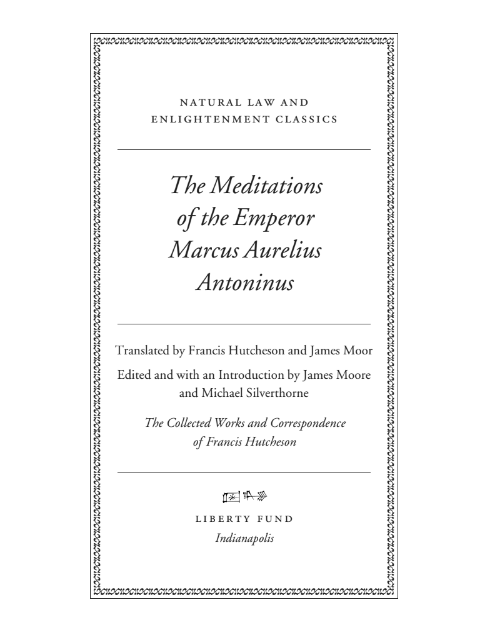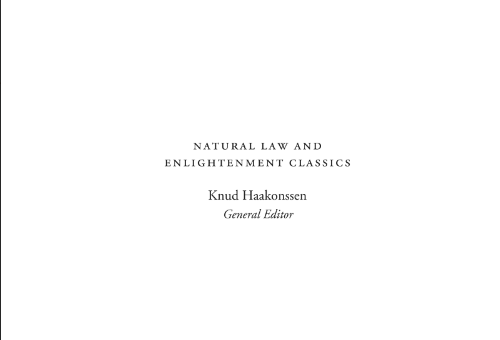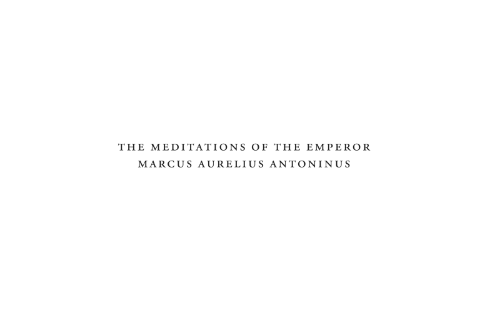


On May 31, 1742, Francis Hutcheson in Glasgow sent to Thomas Drennan in Belfast some copies of The Meditations of the Emperor Marcus Aurelius Antoninus. Newly translated from the Greek: With Notes, and an Account of his Life (Glasgow: Printed by Robert Foulis and sold by him at the College: 1742).¹ The letter that accompanied the dispatch of the books contained the following intriguing account: The bearer Mr. Hay takes over some copies of a new translation of Antoninus, the greater half of which and more, was my amusement last sum- mer, for the sake of a singular worthy soul one Foulis;² but I don’t let my name appear in it, nor indeed have I told it to any here but the Man con- cerned. I hope that you’ll like it; the rest was done by a very ingenious Lad one Moore.³ Pray try your critical faculty in finding what parts I did & what he did. I did not translate books in a suite, but I one or two, & he one or two.
I hope if you like it that it may sell pretty well with you Belfast I am sure it is doing a publick good to diffuse the Sentiments & if you knew Foulis you would think he deserved all encouiragement. Hutcheson’s letter raises a number of questions: (1) Which books of The Meditations contain Hutcheson’s translations and notes and which books should be attributed to Moor? (2) What considerations prompted Hutch- eson to undertake this translation and edition, apart from his announced desire to be of assistance to Robert Foulis and the Foulis press? (3) What might be the significance of Hutcheson’s notes to the text? Do they make up a coherent set of ideas concerning human nature, morals, politics, and religion? And what may be the relevance of these notes for our understanding of his other writings? (4) Why was Hutcheson determined that his name should not appear in the volume and that no one in Glasgow and its environs apart from Foulis should know the identity of the persons responsible for the translation and the notes? (5) And, finally, what was the significance of Hutcheson’s adaptation of The Meditations for the Enlightenment in Scotland?
There is another account of the matter. Thomas Reid entered the fol- lowing note in his own copy of the 1764 edition of The Meditations: “Dr. Moor translated the 9th and 10th books. Dr. Francis Hutcheson the rest. Dr. Hutcheson wrote the Preface and Dr. Moor collected [sic!] the Proofs. This information I had from Dr. Moor.” We believe that Reid’s note is the most authoritative of the three versions of this matter. Books IX and X differ from the other books. The style of the translation of books IX and X lacks the characteristic flow of Hutcheson’s prose. These two books also contain a number of phrases not found elsewhere in the text. “Nature” or “the nature of the whole” is referred to as “she” (for example, bk. IX, art. 1, pp. 107-8)—the Greek phusis is a feminine noun—whereas elsewhere in The Meditations nature is referred to as “it.” In the notes for books IX and X there are a number of references to Greek terminology and to Thomas Gataker’s translation of The Meditations from the Greek into Latin.
A preoccupation with the original Greek of Marcus and with the quality of the translation by Gataker is not a conspicuous feature of the notes found in the other books. It is a concern, however, that might be expected of someone like Moor, who was renowned for the ac- curacy of his command of ancient Greek. In every one of the other books there are extensive notes that expand upon and interpret the philosophy of the Stoics, with the exception of the first book, which is concerned not with ideas but with individuals who influenced Marcus (many of them Stoics). The term Stoic is never used in books IX and X. Finally, in books IX and X, there is an abundance of citations to writers of the New Testa- ment: fourteen in all; twice as many as are found in the notes to all of the other books combined. In light of these considerations, we conclude that Reid’s record of his conversation with Moor may be taken as the most authoritative of the three pieces of external evidence: books IX and X by Moor; the rest by Hutcheson.
What prompted Hutcheson and Moor to undertake this translation and edition of The Meditations? One of their expressed motivations was stylis- tic. They were dissatisfied with the two translations then available in En- glish. One was the translation by Meric Casaubon (1599–1671) published in 1634,⁸ described by Hutcheson as “the old English translation”: it “can scarce be agreeable to any reader; because of the intricate and antiquated stile” (“Life of the Emperor,” p. 3). The other translation, published in 1701 (and reissued in 1714 and 1726), was by Jeremy Collier (1650–1726), a nonjuring Anglican clergyman best known for his attack on the English stage.⁹ This edition was described by Hutcheson as an exercise that “seems not to preserve the grand simplicity of the original.”
Hutcheson tells us that his translation is “almost entirely new” and has been made “according to Gataker’s edition of the original, and his Latin version” (“Life of the Emperor,” p. 4). Thomas Gataker (1574–1654) was an Anglican clergyman with Puritan sympathies, who maintained good relations with Presbyteri- ans and was a member of the Westminster Assembly. Gataker’s edition of The Meditations¹⁰ in Greek, with a translation and commentary on the text in Latin, has been described by a modern classical scholar as “a monument of vast and fastidious erudition,” which “has long been and will always remain, the principal authority for any one undertaking to study or edit the Meditations.”¹¹ An enlarged version was published in London in 1697,¹² with a dedication by George Stanhope (1660–1728) to Lord John Somers and a translation into Latin by Stanhope of a life of Marcus Aurelius, com- posed in French, by André Dacier (1652–1722).


